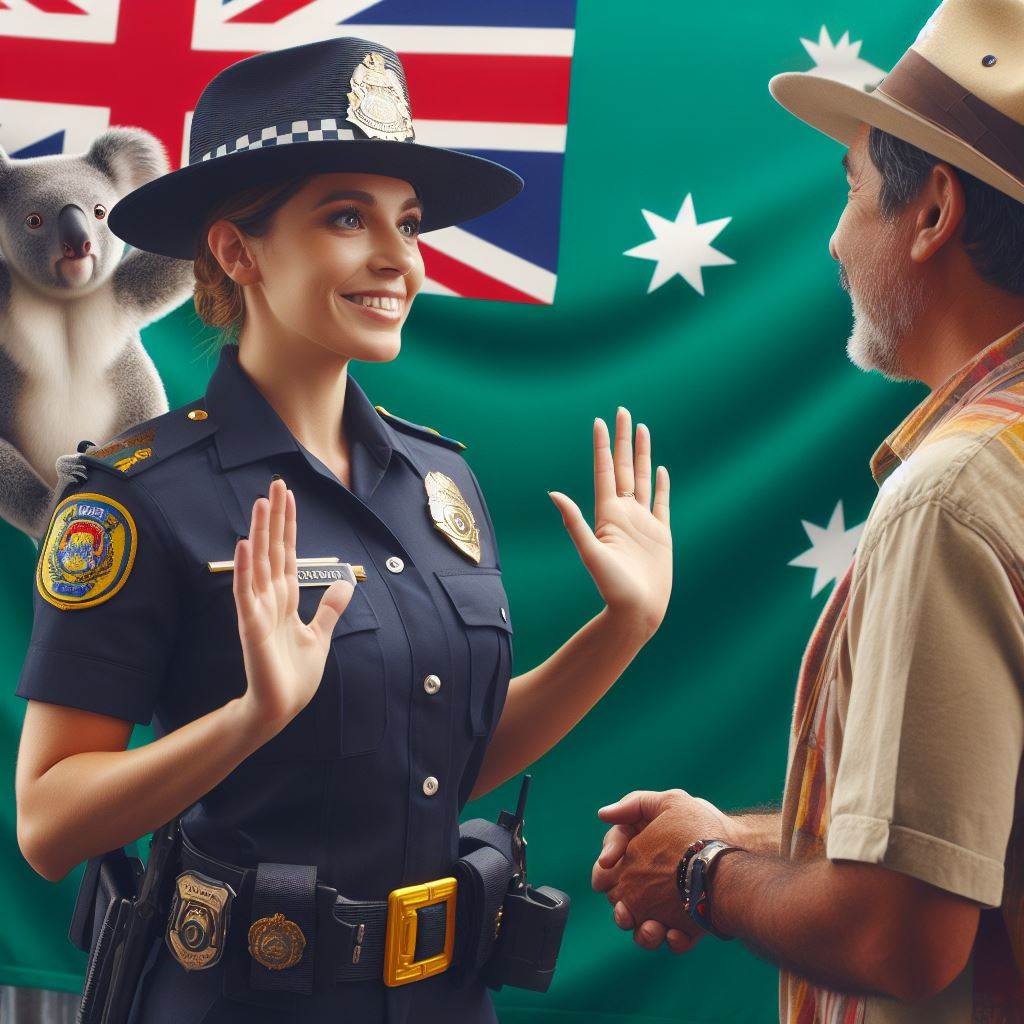Introduction
Diversity in Australia’s Police Forces is an important topic that highlights the need for representation in law enforcement.
This blog post aims to investigate the current state of diversity within Australia’s police forces and its impact on community relations and the effectiveness of policing.
Diversity plays a vital role in law enforcement as it ensures that police forces reflect the diverse communities they serve.
This representation fosters trust and promotes a sense of safety among different cultural, ethnic, and minority groups.
This blog post explores the current state of diversity in Australia’s police forces and discusses its impact on community relations and the effectiveness of policing.
Having a diverse police force allows for better communication and understanding between officers and the community.
It helps bridge the gap between different cultures and assists in resolving conflicts peacefully.
Additionally, diverse perspectives within the police force can lead to innovative solutions and approaches to solving crimes.
Different cultural backgrounds bring unique insights that can aid in investigations and community outreach programs.
Moreover, a diverse police force can help combat issues such as racial profiling and discrimination, ensuring fair treatment for all individuals.
This can build trust and encourage marginalized groups to report crimes and seek help from law enforcement.
In general, diversity in Australia’s police forces is crucial for maintaining strong community relations and enhancing the effectiveness of policing.
By reflecting the population they serve, police forces can foster trust, promote understanding, and address the needs of diverse communities.
Efforts should be made to continue increasing diversity within law enforcement to create a more inclusive and representative police force.
Current state of diversity in Australia’s police forces
Statistics on the representation of different demographic groups
Australia’s police forces have made strides in improving diversity, although there is still progress to be made.
The current statistics show that gender representation is getting better, with more women joining the force in recent years.
However, there is still a significant gender gap, with men comprising the majority of officers.
When it comes to ethnicity, the representation in Australian police forces is not reflective of the overall population.
People from Caucasian backgrounds are disproportionately represented, while other ethnic groups, such as Asians, African Australians, and Middle Eastern Australians, are considerably underrepresented.
The lack of diversity within the police forces is not limited to ethnicity alone.
Indigenous Australians, who have a significant presence in the country, are severely underrepresented.
This lack of representation raises concerns about cultural sensitivity, effective community engagement, and trust-building with Indigenous communities.
The progress made in recent years in improving diversity
In recent years, Australian police forces have taken steps to improve diversity.
Recruitment programs have been designed to actively target underrepresented groups.
These initiatives aim to encourage individuals from diverse backgrounds to consider a career in law enforcement and provide support and mentorship throughout the recruitment process.
The increased representation of women in the police forces is a promising development.
Efforts to address the gender gap have included targeted recruitment campaigns and the implementation of policies that promote equal opportunities for both male and female officers.
Additionally, there have been efforts to improve work-life balance and create a more inclusive workplace culture.
Specifically addressing the underrepresentation of Indigenous Australians in the police forces, various initiatives have been implemented.
These include cultural sensitivity training programs for officers, partnerships with Indigenous communities, and the establishment of dedicated Indigenous liaison positions within the police forces.
Identification of areas where diversity is lacking or needs improvement
Despite the progress made, there are still areas where diversity is lacking or needs improvement within Australia’s police forces.
One significant area is the representation of ethnic minorities.
There is a need for targeted recruitment efforts and initiatives that address the barriers faced by individuals from diverse ethnic backgrounds.
Another area that needs attention is the inclusion of LGBTQ+ individuals within the police forces.
Greater efforts should be made to create an inclusive and supportive environment for LGBTQ+ officers, ensuring equal opportunities and protection against discrimination.
Furthermore, there is a need to expand efforts to improve the representation of Indigenous Australians in the police forces.
This includes increasing recruitments from Indigenous communities, establishing culturally appropriate protocols, and fostering stronger relationships between police and Indigenous leaders.
In review, while there has been progress in improving diversity in Australia’s police forces, there is still work to be done.
Efforts to address underrepresentation need to be ongoing, with targeted recruitment programs, inclusive policies, and cultural sensitivity training.
Only through continuous commitment to diversity can the police forces truly reflect the multicultural fabric of Australia and effectively serve and protect all communities.
Read: Technology’s Impact on Diplomacy
Benefits of diversity in policing
Diversity within Australia’s police forces has become increasingly recognized as a significant aspect that holds numerous benefits.
The advantages of having a diverse police force extend far beyond just meeting diversity quotas; it plays a critical role in ensuring effective policing and maintaining social harmony within communities.
Improved community relations and trust
Having a diverse police force can help build stronger connections and trust with different communities.
One of the key benefits of diversity in policing is improved community relations and trust. When community members can see police officers who reflect their own diverse backgrounds, they are more likely to feel comfortable and trust in the police.
This trust allows for better cooperation, communication, and collaboration between the police and the various communities they serve.
Enhanced understanding and empathy for diverse communities
Officers from various backgrounds can better comprehend and empathize with the unique challenges faced by different communities.
Moreover, a diverse police force brings forth enhanced understanding and empathy for diverse communities.
Police officers from different cultural, ethnic, and socio-economic backgrounds have a better understanding of the challenges faced by these communities.
This understanding enables them to provide more effective support, assistance, and crime prevention strategies tailored to the specific needs of each community.
It also helps in bridging gaps and breaking down barriers, leading to improved relationships between the police and the community.
Ability to effectively tackle a wider range of crime and social issues
A diverse police force brings together a variety of perspectives, skills, and experiences, enabling them to address a broader spectrum of crime and social problems.
Another advantage of diversity in policing is the ability to effectively tackle a wider range of crime and social issues.
Different communities may experience specific types of crimes or social challenges that require a unique approach for effective resolution.
A diverse police force brings together officers with a wide range of experiences, skills, and perspectives, enabling them to tackle a broader spectrum of problems.
This diversity of thought and expertise allows for more creative and innovative solutions to complex issues, benefiting the entire community.
Increased accuracy and fairness in decision-making
When decision-making involves individuals from diverse backgrounds, it reduces the risk of biases and ensures a fairer outcome.
Finally, diversity within the police force contributes to increased accuracy and fairness in decision-making.
When decisions are made by a diverse group of individuals, it diminishes the impact of personal biases.
This fairness ensures that the rights of all individuals, regardless of their background, are protected and respected.
It also fosters a sense of equality and justice, enhancing the overall legitimacy of the police force.
In essence, diversity within Australia’s police forces brings innumerable benefits.
Improved community relations, enhanced understanding of diverse communities, the ability to tackle a wider range of issues, and increased fairness in decision-making are some of the advantages that pave the way for effective policing and a harmonious society.
Recognizing the importance of diversity and actively promoting it within police forces is crucial for building safer, more inclusive communities.
Read: Understanding Ranks in Australian Police Force
Your Personalized Career Strategy
Unlock your potential with tailored career consulting. Get clear, actionable steps designed for your success. Start now!
Get StartedExplore Further: Firefighting Dogs: Heroes on Four Paws
See Related Content: Firefighter Training: What It Takes in AU
Challenges and obstacles to diversity in law enforcement
- Historical factors or systemic issues that have hindered diversity.
- Challenges faced in recruiting and retaining diverse candidates.
- Lack of representation at higher ranks and leadership positions.
- Negative stereotypes and biases that discourage diverse individuals from joining the police forces.
Historically, diversity has been hindered within Australia’s police forces due to various factors. These include biases, discrimination, and systemic issues that have limited the representation of diverse individuals in law enforcement.
Recruiting and retaining diverse candidates pose significant challenges for police forces.
This can be attributed to a lack of outreach to diverse communities, limited resources for recruitment, and the perception of law enforcement as unwelcoming or discriminatory towards certain groups.
Another obstacle to diversity in police forces is the lack of representation at higher ranks and leadership positions.
Diverse officers often face barriers to career advancement, which can result in limited diversity among those making important decisions within the force.
Negative stereotypes and biases also discourage diverse individuals from joining the police forces.
These stereotypes may include assumptions about cultural norms, language barriers, or negative experiences with law enforcement within their communities.
Addressing these challenges and obstacles
Addressing these challenges and obstacles is crucial to fostering diversity within Australia’s police forces.
To promote diversity, police forces need to prioritize efforts to overcome historical barriers, diversify their recruitment strategies, and ensure equal opportunities for career progression.
One approach to overcoming historical barriers is through education and training.
Police forces can implement programs that raise awareness about biases, discrimination, and systemic issues, promoting understanding and inclusivity among officers.
Recruitment strategies should be tailored to reach diverse communities and address their specific needs and concerns.
This may involve partnering with community organizations, conducting targeted outreach campaigns, and offering support networks to prospective diverse candidates.
Creating a more inclusive and diverse leadership structure within police forces is also vital.
Efforts should be made to identify and nurture diverse candidates for leadership roles, including implementing mentorship programs, providing training opportunities, and reevaluating promotion criteria to address any existing biases.
Additionally, it is important to challenge negative stereotypes and biases within the wider community.
Police forces can collaborate with community leaders, organizations, and educators to promote positive perceptions of law enforcement and highlight the benefits of diversity within the force.
In fact, achieving diversity within Australia’s police forces requires addressing challenges such as historical factors, recruitment and retention difficulties, a lack of representation in leadership positions, and negative stereotypes.
By actively addressing these obstacles, police forces can create a more inclusive and representative law enforcement community.
Read: Future of Diplomacy: Australia’s Role

Initiatives and Strategies for Promoting Diversity
Implementing initiatives and strategies to promote diversity in Australia’s police forces is crucial for creating a more inclusive and representative law enforcement system.
By actively engaging in various practices, police forces can attract diverse candidates, enhance cultural competency, and foster collaboration with community organizations and diversity advocates.
Let’s explore some successful initiatives and strategies that have been implemented:
Examples of Successful Initiatives
Several police forces across Australia have successfully implemented initiatives to promote diversity. One noteworthy example is the Victoria Police force, which launched the Multicultural Liaison Officer program.
This initiative aims to build trust and strengthen relationships between police officers and culturally diverse communities by assigning officers as liaisons in specific communities.
The success of this program has led to enhanced communication and community cooperation.
The New South Wales Police Force has also made significant strides towards diversity by launching the “Just Like You” campaign.
This initiative aims to attract candidates from various ethnic backgrounds and inspire community-minded individuals to join the force.
Through this campaign, the police force has been able to improve representation and foster a more inclusive work environment.
Recruitment Strategies
To attract diverse candidates, police forces have implemented specific recruitment strategies.
These strategies involve reaching out to various communities and providing equal opportunities for all individuals interested in a career in law enforcement.
For example, targeted advertising campaigns in multicultural media channels and recruitment drives at community events have proven effective in attracting individuals from different cultural backgrounds.
Furthermore, some police forces have introduced cadet programs and scholarship opportunities specifically designed to encourage diverse candidates to pursue a career in law enforcement.
These programs provide mentorship and support for candidates from different backgrounds, helping them navigate the recruitment process and succeed in their policing careers.
Training Programs for Cultural Competency and Sensitivity
Training programs play a crucial role in enhancing the cultural competency and sensitivity of police officers.
These programs aim to educate officers about various cultures, traditions, and customs present in the community they serve.
By undergoing cultural awareness training, officers can better understand and respond to the needs and concerns of diverse communities, resulting in improved trust and collaboration.
Moreover, diversity training programs also focus on implicit bias awareness and promote fair and equitable treatment of all individuals, regardless of their background.
Such training enables officers to provide quality service without any prejudice, fostering a safe and inclusive environment for both officers and community members.
Collaboration with Community Organizations and Diversity Advocates
To facilitate diversity and inclusion, Australian police forces actively collaborate with community organizations and diversity advocates.
These collaborations aim to develop joint initiatives, implement policies, and establish feedback mechanisms to ensure continuous improvement.
By partnering with community leaders and advocates, police forces can gain valuable insights and perspectives, better addressing the needs and concerns of diverse communities.
Additionally, these collaborations emphasize community policing and encourage proactive engagement with community members.
Through initiatives such as community forums, cultural festivals, and diversity events;
Police forces can build trusting relationships, improve communication, and bridge the gap between law enforcement and the community.
In a nutshell, promoting diversity in Australia’s police forces requires a multifaceted approach.
Initiatives and strategies such as the Multicultural Liaison Officer program, recruitment strategies;
Training programs, and collaboration with community organizations are instrumental in fostering inclusivity and representation within law enforcement.
By actively implementing these practices, police forces can create a more diverse and culturally competent workforce;
Thereby strengthening relationships with communities and ensuring effective policing for all.
Stand Out with a Resume That Gets Results
Your career is worth more than a generic template. Let us craft a resume and cover letter that showcase your unique strengths and help you secure that dream job.
Get HiredRead: How to Become a Police Officer in Australia
Conclusion
The importance of diversity in Australia’s police forces cannot be overstated.
It brings a variety of perspectives, experiences, and skills that enhance law enforcement efforts.
By embracing diversity and inclusion, we can build trust and improve community relations.
However, the journey towards achieving true diversity is far from over.
It is crucial to continue efforts to promote diversity in police recruitment, training, and leadership positions.
This will ensure that police forces reflect the communities they serve, fostering greater understanding and empathy.
The impact of increased diversity in policing has the potential to create safer and healthier communities.
It can lead to more effective crime prevention strategies, better communication with diverse populations, and reduced stereotypes and biases.
In turn, this leads to enhanced trust and cooperation between law enforcement and the public.
To truly create a police force that represents and understands the multicultural fabric of Australia;
We must actively work towards breaking down barriers and biases.
By actively seeking out diverse candidates and creating an inclusive and supportive work environment;
We can ensure that our police forces are equipped to address the complex challenges of modern society.
In closing, diversity is not just a buzzword or a box to tick but a vital component in creating strong, inclusive, and successful police forces.
Let us continue to champion diversity and inclusion in law enforcement, for the betterment of our communities and the safety and well-being of all Australians.




